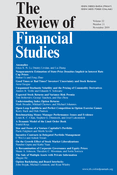-
Views
-
Cite
Cite
Mark Broadie, Mikhail Chernov, Michael Johannes, Understanding Index Option Returns, The Review of Financial Studies, Volume 22, Issue 11, November 2009, Pages 4493–4529, https://doi.org/10.1093/rfs/hhp032
Close - Share Icon Share
Abstract
Previous research concludes that options are mispriced based on the high average returns, CAPM alphas, and Sharpe ratios of various put selling strategies. One criticism of these conclusions is that these benchmarks are ill suited to handle the extreme statistical nature of option returns generated by nonlinear payoffs. We propose an alternative way to evaluate the statistical significance of option returns by comparing historical statistics to those generated by option pricing models. The most puzzling finding in the existing literature, the large returns to writing out-of-the-money puts, is not inconsistent (i.e., is statistically insignificant) relative to the Black-Scholes model or the Heston stochastic volatility model due to the extreme sampling uncertainty associated with put returns. This sampling problem can largely be alleviated by analyzing market-neutral portfolios such as straddles or delta-hedged returns. The returns on these portfolios can be explained by jump risk premiums and estimation risk.




